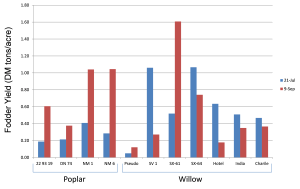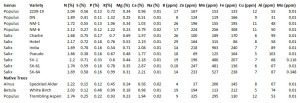This research note is part of a series detailing results from different facets of the trial. For more information, see:
2015 Sheep Production Report on Fodder Tree Diet
2015 Sheep Preferences of Fodder Trees
Economic Analysis and Practical Applications of Fodder Trees
RAIN has partnered with the Ontario Sheep Marketing Agency to investigate whether fast-growing, coppiced trees can be a nutritionally and economically viable fodder source for sheep. This project is taking place over the 2015 and 2016 growing seasons near Sault Ste Marie.
Method
In 2007, a short rotation woody coppice plantation was established by the Canadian Forest Service to assess the potential of fast growing willow and poplar for bioenergy. A section of this plantation was fenced off and split into four 0.75 acre paddocks. Trees were cut to 4” and allowed to regrow to heights of 12-24” before sixty mature, dry, Arcott Outaouais ewes rotationally grazed the new re-growth. Outside the grazed area, three species of native trees (Speckled Alder, Trembling Aspen, and White Birch) were also coppiced for comparison with the domestic varieties. Samples of the new growth were taken to determine dry matter yields and nutrient content of the tree re-growth.
Results
Tree Yield: Dry matter (DM) yield was assessed at two times during the growing season. Yields of tree crops in July ranged from 0.05 tons/acre to 1.07 tons/acre with an average of a 0.49 tons/acre. This sample included the entire succulent stem. In September, DM yields for leaves only ranged from 0.12 tons/acre to 1.61 tons/acre with an average of 0.61tons/acre.

Figure 1. Dry matter yield (tons/acre) in the existing arrangement of fast growing willow and poplar fodder varieties for July and September 2015.
Click graph to enlarge
Nutritional Content of Trees: Leaf samples were sent to A&L Laboratories Canada for macro- and micro-nutrient analysis. Nutrient levels were reported for nitrogen (N), sulphur (S), phosphorus (P), potassium (K), magnesium (Mg), calcium (Ca), sodium (Na), copper (Cu), boron (B), zinc (Zn), manganese (Mn), iron (Fe), aluminum (Al), and molybdenum (Mo).
The data were analyzed to compare different groups of trees as follows:
- Domestic (ie: artificially selected hybrids of fast-growing willow and poplar) vs native trees
- All willow (genus Salix) vs all poplar (genus Populus – includes native Trembling Aspen)
- Domestic willow (genus Salix – all willows were domestic) vs domestic poplar (genus Populus)
There were no statistically significant differences between any of the above tree groups for N (which is closely related to crude protein content), Na, B, Zn, Fe, or Mo.
Domestic tree varieties had significantly higher levels of S and Mg than native trees.
When comparing all willows to all poplars, willows had significantly higher levels of S, Mg, Ca, and Al. Poplars had significantly higher levels of K and Cu.
Some results changed when native Trembling Aspen was removed from the poplar group. When comparisons between willows and poplars were done using only domestic trees, willows had significantly higher levels of P, Mg, Ca, Mn, and Al. Poplars had significantly higher levels of Cu.
Click on table to enlarge
Thanks to our farmer co-operators Colleen Alloi and Brent Atwell for their assistance with this project.



Comments 4
Pingback: Rural Agri-Innovation Network (RAIN) - 2015 Sheep Production Report on Fodder Tree Diet | Rural Agri-Innovation Network (RAIN)
Pingback: Rural Agri-Innovation Network (RAIN) - 2015 Sheep Preferences of Fodder Trees | Rural Agri-Innovation Network (RAIN)
Pingback: Rural Agri-Innovation Network (RAIN) - Economic Analysis and Practical Applications of Fodder Trees | Rural Agri-Innovation Network (RAIN)
WHICH FODDERS TREES CAN GROW UP TREES FASTERS .
IF YOU NAME IT PLEASE LET ME KNOW ABOUT THANK
I DO WANT TO BUY IT . OR WHERE CAN BUY IT